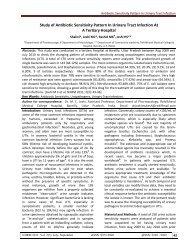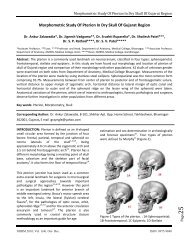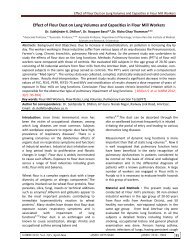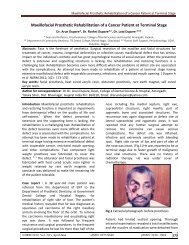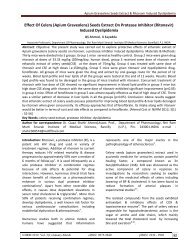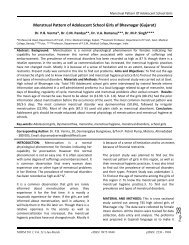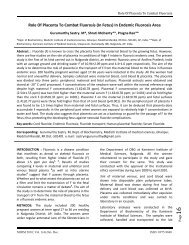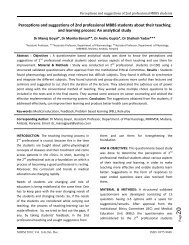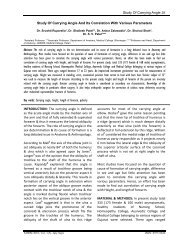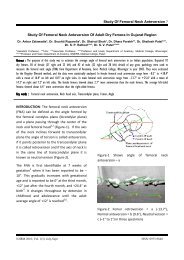Comparative Study of Fenugreek Seeds on Glycemic Index
Comparative Study of Fenugreek Seeds on Glycemic Index
Comparative Study of Fenugreek Seeds on Glycemic Index
Create successful ePaper yourself
Turn your PDF publications into a flip-book with our unique Google optimized e-Paper software.
<str<strong>on</strong>g>Comparative</str<strong>on</strong>g> <str<strong>on</strong>g>Study</str<strong>on</strong>g> <str<strong>on</strong>g>of</str<strong>on</strong>g> <str<strong>on</strong>g>Fenugreek</str<strong>on</strong>g> <str<strong>on</strong>g>Seeds</str<strong>on</strong>g> <strong>on</strong> <strong>Glycemic</strong> <strong>Index</strong><br />
tests is represented by their glycaemic resp<strong>on</strong>ses,<br />
which are defined as the incremental area under<br />
the blood glucose resp<strong>on</strong>se curves. It has been<br />
known for many years that different carbohydrate<br />
foods, with the same macro nutrient compositi<strong>on</strong>,<br />
produce different glycaemic resp<strong>on</strong>ses 36 . In the<br />
present study also we found that Rice and Wheat<br />
diets produced different glycaemic resp<strong>on</strong>ses,<br />
wheat having a significantly lower glycaemic<br />
resp<strong>on</strong>se than that <str<strong>on</strong>g>of</str<strong>on</strong>g> rice and both having lower<br />
glycaemic resp<strong>on</strong>ses compared to glucose. We also<br />
observed lowering effects <str<strong>on</strong>g>of</str<strong>on</strong>g> fenugreek <strong>on</strong><br />
glycaemic resp<strong>on</strong>ses, when added to rice and<br />
wheat diets.<br />
As reported earlier by different authors, we also<br />
observed a significant difference in the GI <str<strong>on</strong>g>of</str<strong>on</strong>g><br />
different foods c<strong>on</strong>taining equivalent amount <str<strong>on</strong>g>of</str<strong>on</strong>g><br />
carbohydrate. It has suggested that several factors<br />
such as physical form <str<strong>on</strong>g>of</str<strong>on</strong>g> the preparati<strong>on</strong>, nature <str<strong>on</strong>g>of</str<strong>on</strong>g><br />
cooking, presence <str<strong>on</strong>g>of</str<strong>on</strong>g> anti nutrients, fat, protein,<br />
and dietary fiber influence the GI <str<strong>on</strong>g>of</str<strong>on</strong>g> the particular<br />
food, although the role <str<strong>on</strong>g>of</str<strong>on</strong>g> some <str<strong>on</strong>g>of</str<strong>on</strong>g> these factors is<br />
doubtful. Wheat and rice differ in their c<strong>on</strong>stituent<br />
proteins and lipids 37 .<br />
It has been shown earlier that there is no<br />
correlati<strong>on</strong> between GI and nutrient protein and<br />
fat c<strong>on</strong>tent <str<strong>on</strong>g>of</str<strong>on</strong>g> various preparati<strong>on</strong>s which<br />
indicates that these nutrients cannot influence the<br />
GI. Recently, it has been suggested that the effect<br />
<str<strong>on</strong>g>of</str<strong>on</strong>g> protein and fat <strong>on</strong> GI are not observed unless<br />
they are present in amounts <str<strong>on</strong>g>of</str<strong>on</strong>g> 25g/50g <str<strong>on</strong>g>of</str<strong>on</strong>g><br />
carbohydrate 38 . All the dietary preparati<strong>on</strong>s used in<br />
the study c<strong>on</strong>tained less than 25grams <str<strong>on</strong>g>of</str<strong>on</strong>g> protein<br />
or fat/50grams <str<strong>on</strong>g>of</str<strong>on</strong>g> carbohydrate. Hence the<br />
significant differences in GI observed between rice<br />
and wheat are not due to the differences in their<br />
compositi<strong>on</strong> but due to the different c<strong>on</strong>figurati<strong>on</strong><br />
and different modes <str<strong>on</strong>g>of</str<strong>on</strong>g> preparati<strong>on</strong>. The<br />
unavailable carbohydrate (Dietary fiber) is lower in<br />
rice than that in wheat. The wheat preparati<strong>on</strong><br />
(chapatti) is partially cooked whereas the rice<br />
preparati<strong>on</strong> (Boiled rice) is completely cooked 39 .<br />
The metabolic effects <str<strong>on</strong>g>of</str<strong>on</strong>g> fenugreek seeds may be<br />
divided into acute and chr<strong>on</strong>ic <strong>on</strong>es. Several<br />
authors reported the post prandial glucose<br />
lowering effects <str<strong>on</strong>g>of</str<strong>on</strong>g> fenugreek when administered<br />
c<strong>on</strong>currently and used for some time al<strong>on</strong>g with<br />
the diets. In the present study we observed the<br />
acute effects <str<strong>on</strong>g>of</str<strong>on</strong>g> fenugreek <strong>on</strong> glycaemic resp<strong>on</strong>se<br />
<str<strong>on</strong>g>of</str<strong>on</strong>g> wheat and rice. As reported earlier we also<br />
found significant lowering in GI values <str<strong>on</strong>g>of</str<strong>on</strong>g> both the<br />
foods tested when fenugreek is given al<strong>on</strong>g with<br />
them. The delayed and reduced rise in plasma<br />
glucose, hence the lower glycaemic resp<strong>on</strong>se and<br />
GI values may be due to delayed gastric<br />
emptying 40 , delayed intra luminal glucose<br />
diffusi<strong>on</strong> 41, 42 leading to decreased intestinal transit<br />
time 43,44 or delayed nutrient absorpti<strong>on</strong>. All these<br />
are shown to be the causes <str<strong>on</strong>g>of</str<strong>on</strong>g> low GI exhibited by<br />
various foods in the presence <str<strong>on</strong>g>of</str<strong>on</strong>g> soluble fiber.<br />
Whole fenugreek seeds are the rich sources <str<strong>on</strong>g>of</str<strong>on</strong>g><br />
soluble fiber in the form <str<strong>on</strong>g>of</str<strong>on</strong>g> galactomannans, which<br />
resemble guar gum in chemical structure and<br />
viscosity. Subsequently, it has been shown in<br />
experimental studies that galactomannans derived<br />
from fenugreek seeds has an inhibitory effect <strong>on</strong><br />
starch digesti<strong>on</strong>. Based <strong>on</strong> this informati<strong>on</strong>, it has<br />
been postulated that galactomannan, present in<br />
the fenugreek seeds, may be resp<strong>on</strong>sible for its<br />
hypoglycaemic effect 45 . Recently a French group<br />
isolated 4-hydroxyleucine, a novel amino acid from<br />
fenugreek seeds, which is not present in<br />
mammalian tissues.<br />
It is reported that 4-hydroxy leucine simulates<br />
insulin secreti<strong>on</strong> through a direct acti<strong>on</strong> <strong>on</strong><br />
pancreatic - cells in experimental animals and in<br />
humans 46 . The stimulating effect <str<strong>on</strong>g>of</str<strong>on</strong>g> 4-hydroxy<br />
leucine is strictly glucose dependent and is devoid<br />
<str<strong>on</strong>g>of</str<strong>on</strong>g> any secretory effect under normal<br />
c<strong>on</strong>centrati<strong>on</strong>s <str<strong>on</strong>g>of</str<strong>on</strong>g> glucose, hence the absence <str<strong>on</strong>g>of</str<strong>on</strong>g><br />
risk <str<strong>on</strong>g>of</str<strong>on</strong>g> hypoglycaemia. Besides insulinotrophic<br />
effects, experimental studies c<strong>on</strong>ducted in Zucker<br />
fa/fa rats dem<strong>on</strong>strated that 4- hydroxyl isoleucine<br />
can reduce insulin resistance through activati<strong>on</strong> <str<strong>on</strong>g>of</str<strong>on</strong>g><br />
the early steps <str<strong>on</strong>g>of</str<strong>on</strong>g> insulin signaling in peripheral<br />
tissues and liver, and extend a direct effect by<br />
improving sensitivity to insulin. This may be<br />
especially important in NIDDM patients in whom<br />
insulin resistance predominates. Our present study<br />
supports the beneficial effects <str<strong>on</strong>g>of</str<strong>on</strong>g> fenugreek in<br />
lowering <str<strong>on</strong>g>of</str<strong>on</strong>g> GI through its c<strong>on</strong>stituents <str<strong>on</strong>g>of</str<strong>on</strong>g> soluble<br />
fiber, mainly the galactomannans and 4-<br />
hydroxyleucine.<br />
We observed relatively delayed and comparatively<br />
lower peak and lower total increments <str<strong>on</strong>g>of</str<strong>on</strong>g> blood<br />
NJIRM 2011; Vol. 2(3). July- September eISSN: 0975-9840 pISSN: 2230 - 9969 34



